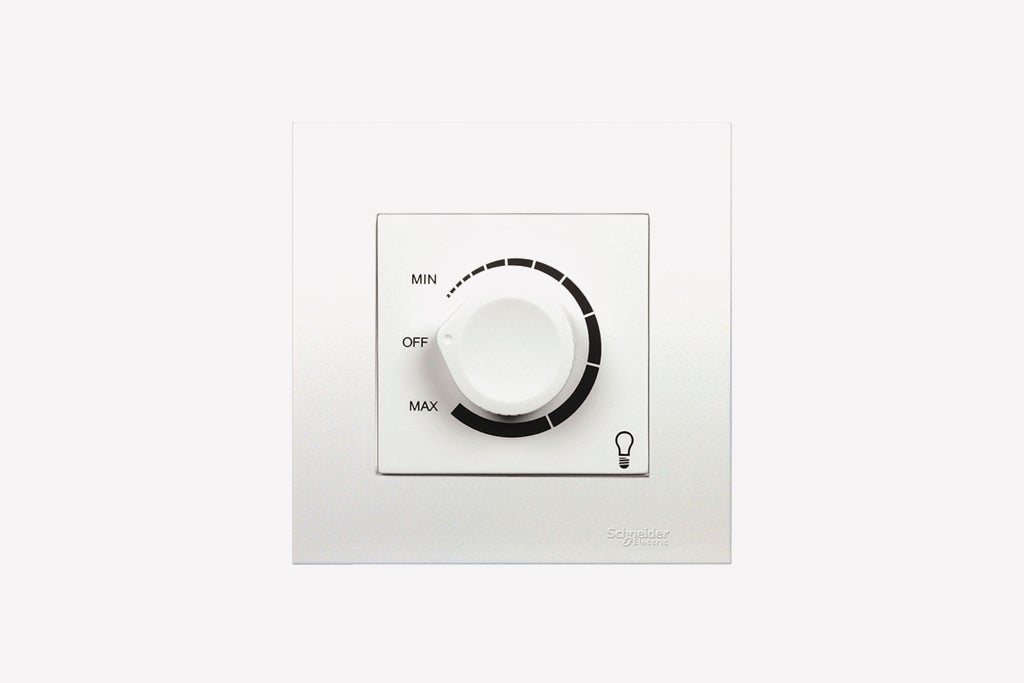Introduction to Light Dimmers and Fan Regulators
The biggest marker for the success of an electrical appliance is how seamlessly it fits into our everyday life. The more effortlessly a device, equipment, or electrical accessory fits into our life, the better its core design and application. Two such innovations are ceiling fans and lights. These electrical equipments are indispensable to our lifestyle. We as people cannot imagine life without lights or a cooling fan. These devices come equipped with mechanisms to regulate and control their operations.
Ceilings fans are controlled using regulators and lights are controlled using dimmers. Most of us don’t even give these electrical accessories a second glance. Yet these offer many benefits and make the functioning of our home far easier than we realize. In the next section, let’s dive into the importance of fan regulators and light dimmers, respectively.
All You Need To Know About Fan Regulators
Regulators in ceiling fans are used to control and regulate the speed of the fan. Specifically, regulators control fans by controlling the voltage passing through to the fans. These simple but effective devices have been around since the 1950s and come in many types. These are:
- Electric Regulator - These are traditional and bulky regulators that can be seen in old homes. The basic mechanism of an electric regulator includes the presence of resistors to reduce the voltage of the ceiling fan. The downside of this type of regulator is that it heats up while controlling the voltage and hence, no electricity is saved by decreasing its speed. These regulators are not used as often because they get damaged easily because of internal heat build-up. However, these regulators are a very cost-effective option and are cheap compared to electronic regulators.
- Electronic Regulator - Such regulators are quickly replacing electric regulators. Electronic regulators have capacitors instead of resistors to decrease the voltage. How capacitors work by controlling the waveform of the power supply. Hence, these do not get heated up easily even as the fan runs at lower speeds. This aids in saving on electricity consumption, where almost 30-40% of electricity is conserved when the fan runs at a lower speed. Electronic regulators further come in 2 types:
Related Read: Smart Lighting For A Better Home
- Movable Type: These do not come with a stepped number but can still control the speed of fans seamlessly. They move smoothly on the electric dashboard and are better than electric regulators. A movable type of electronic regulator is also a more cost-effective option.
- Stepped Type: Considered being the most efficient regulators, step type regulators have numbered steps. These do not heat easily and are equally cost-effective. Stepped type of electronic regulators is gaining a lot of popularity since they are more durable.
Benefits of Using Fan Regulators.
Regulators control the functioning of your fan and also help regulate voltage consumption. Apart from these, its core benefits are:
1) Speed Control - While you can’t control the external weather, you can control the internal ventilation of your room with the aid of fan regulators. You can choose the speed that best works for you. So increase or decrease the fan speed depending on how hot or cold you feel.
2) Reduces Electrical Consumption - When you use a regulator to control your fans’ speed, you are also reducing electrical consumption. Reducing the speed of your fan immediately helps reduce power consumption. Hence, you may have noticed reduced electricity bills during the winter months, owing to less need for fans.
All You Need To Know About Light Dimmers
Unlike fan regulators, dimmers are a more recent technology but equally great when it comes to reducing electrical consumption. A dimmer is a device that controls the brightness of incandescent, fluorescent lamps. These dimmers are used with specific dimmable bulbs. It’s important to note that these dimmers will not work on regular LED bulbs.
With the aid of a dimmer, you can control the light output and brightness of your light bulbs. The intensity of these bulbs can be altered based on your space and occasion. These offer a great multi-purpose use because you can use a single light to create multiple moods and effects for your house. Since dimmers are a more recent technology that is now catching on, it’s important to know what to look for when purchasing a dimmer. You can start by identifying the different brightness levels offered. Secondly, check for the type of light, wattage, single or multi-place, and the style of the dimmer. Checking these factors beforehand will help you purchase a light dimmer that works best for your residential or commercial space.
Also Read: Contactors - The Building Blocks of Electrical Systems
Advantages of Light Dimmers
1) Enhances Interiors - Using light dimmers allows you to control the lighting in your room to best suit your needs. For instance, if you need to read, then you can increase the brightness and if you want a more relaxed ambiance, then you can decrease the brightness. This also helps save costs in installing multiple lights in the same room.
2) Cost-Effective - Light dimmers are highly effective in reducing power consumption. These lights are considered environment-friendly because they help regulate and reduce electricity use. In addition, the reduced use also means a lower electricity bill. Light dimmers and dimmable bulbs are more durable and can easily assimilate into any of your living spaces.
Light Dimmers and Fan Regulators by Schneider Electric.
Schneider Electric is a brand that offers some of the best in electrical devices and appliances. Their wide range of modern and intuitive fan regulators and light dimmers are no exception. These come in multiple varieties and prices so you can pick one that best suits your needs. So upgrading your living space in the most cost-effective way, head to Schneider Electric.


Comments